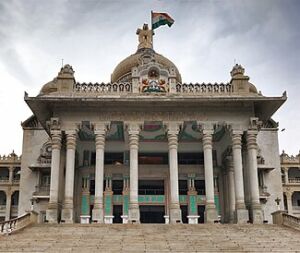Vidhana Soudha Bangalore
Description
Vidhana Soudha Bangalore
Information:
The two houses of the legislature of the princely state of Mysore, the Legislative Assembly and the Legislative Council, were established in 1881 and 1907. Sessions of the two houses were held in Mysore (with joint sessions in the Bangalore Town Hall) until India's independence from British rule on 15 August 1947, when Mysore acceded to India. The state capital was moved to Bangalore; the two houses moved to Attara Kacheri, a British building in Cubbon Park that housed the Mysore High Court.
The need for more spacious legislative quarters than Attara Kacheri was felt in April 1951. The foundation stone of the building was laid by Jawaharlal Nehru, the first Prime Minister of India, on 13 July 1951.The structure was planned as a two-story building to house the assembly and council.
Kengal Hanumanthaiah succeeded K. C. Reddy as Chief Minister of Mysore after the 1952 elections.Hanumanthaiah called the existing plan a "plain and simple type of American architecture" and ordered extensive revisions to create "a work of art in keeping with the tradition of the Mysore state". In addition to the House Chambers, the revised plan included government offices, archives, a library and a banqueting hall.
Construction of the building was completed in 1956. Hanumanthiah personally supervised and commissioned several specific aspects of the construction; one of which was to inscribe "Government Work Is God's Work" and its equivalent in Kannada on the front facade plinth. The final design was to overshadow the British-built Attara Kacheri, currently the seat of the Karnataka High Court, opposite which the Vidhana Soudha was built.
Architecture:
Constructed of granite, the Vidhana Soudha is the largest legislative building in India. It measures 213.36 by 106.68 meters (700.0 by 350.0 ft) on the ground and is 53.34 meters (175.0 ft) tall. The architecture incorporates elements of styles from the medieval Chalukya, Hoysala and Vijayanagara empires of Karnataka.
Its east-facing front facade has a veranda with 12 granite columns 12 meters (40 ft) high. A staircase with 45 steps, more than 61 meters (200 ft) wide, leads to the veranda. The central dome, 18 meters (60 ft) in diameter, is crowned with an effigy of the national emblem of India.
The phrase "Government work is God's work" and its Kannada equivalent "Sarkarada kelasa devara kelasa" (in Kannada script as "सरकाराद कोग देस देस देवरा काद) are inscribed on the 1. In 1957, the Mysore government planned to replace the Satyameva Jayate inscription at a cost of 7 ₹500 (equivalent to ₹750,000 or US$9,400 in 2023),[9] but there was no change. In 1996, the inscription inspired US Governor George Voinovich of Ohio to propose etching "With God all things are possible" on the Ohio Statehouse, sparking a high-profile lawsuit.
The construction cost at the time was ₹17.5 million (equivalent to ₹2.0 billion or US$25 million in 2023). Currently, the annual maintenance cost is more than ₹20 million (US$250,000) including repairs, painting and other miscellaneous expenses.
Bangalore landmark:
Standing tall as a symbolic landmark, the Vidhana Soudha dominates the Bangalore skyline with its imposing structure. Its distinctive silhouette and majestic presence make it an instantly recognizable and defining element of the city's architectural panorama.
Architectural Marvel:
Built in the Neo-Dravidian architectural style, Vidhana Soudha represents a fusion of traditional elements and modern design. Decorated with colossal pillars, arches and intricate carvings, the building's symmetrical layout exemplifies architectural brilliance and meticulous craftsmanship.
Headquarters:
As the legislative center of Karnataka, the Vidhana Soudha is the seat of the state legislature, housing the Legislative Assembly and the Secretariat. It serves as the epicenter of administration where major administrative decisions are discussed and taken.
Historical significance:
Construction of the Vidhana Soudha began in 1952 under Chief Minister Kengal Hanumanthaiah to symbolize Karnataka's cultural identity and post-independence prosperity. Its completion in 1956 marked a significant milestone in the state's history.
Intricate details:
The exterior of the Vidhana Soudha is adorned with ornate sculptures, intricate motifs and detailed carvings that showcase the rich tapestry of Indian art and heritage. Every architectural detail reflects a deep-rooted connection with the cultural ethos of Karnataka.
Symbol of democracy:
Apart from its physical presence, the Vidhana Soudha embodies democratic principles and legislative processes. It symbolizes the essence of democracy, transparency and governance and serves as a sacred space where laws are formulated and democratic ideals are promoted.
Tourist attraction:
The architectural splendor and historical significance of Vidhana Soudha make it a prominent tourist attraction in Bangalore. Visitors from all over the world flock to witness its magnificence, especially during the evenings when the building is illuminated, creating a captivating spectacle.
Cultural heritage:
The building stands as a custodian of the rich cultural heritage of Karnataka, preserving and reflecting the historical heritage and traditions of the state. It has cultural significance, representing the aspirations and achievements of the people of Karnataka.
Remember, the joy of exploration knows no bounds, and we encourage you to continue delving into the beauty and intricacies of [topic/place]. Your curiosity fuels our passion to share these experiences, and we're immensely grateful for your support and engagement.
There are more places to visit in Bangalore;
- https://yesnearme.com/business/sugrrva-vekateshwara-temple/
- https://yesnearme.com/business/karnataka-bhel-house-basavanagudi/
- https://yesnearme.com/business/puchkas-marathahalli/
- https://yesnearme.com/business/sri-sairams-chats-and-juice-malleshwaram/
Contact Information
Contact Listings Owner Form
Review
Login to Write Your ReviewThere are no reviews yet.


